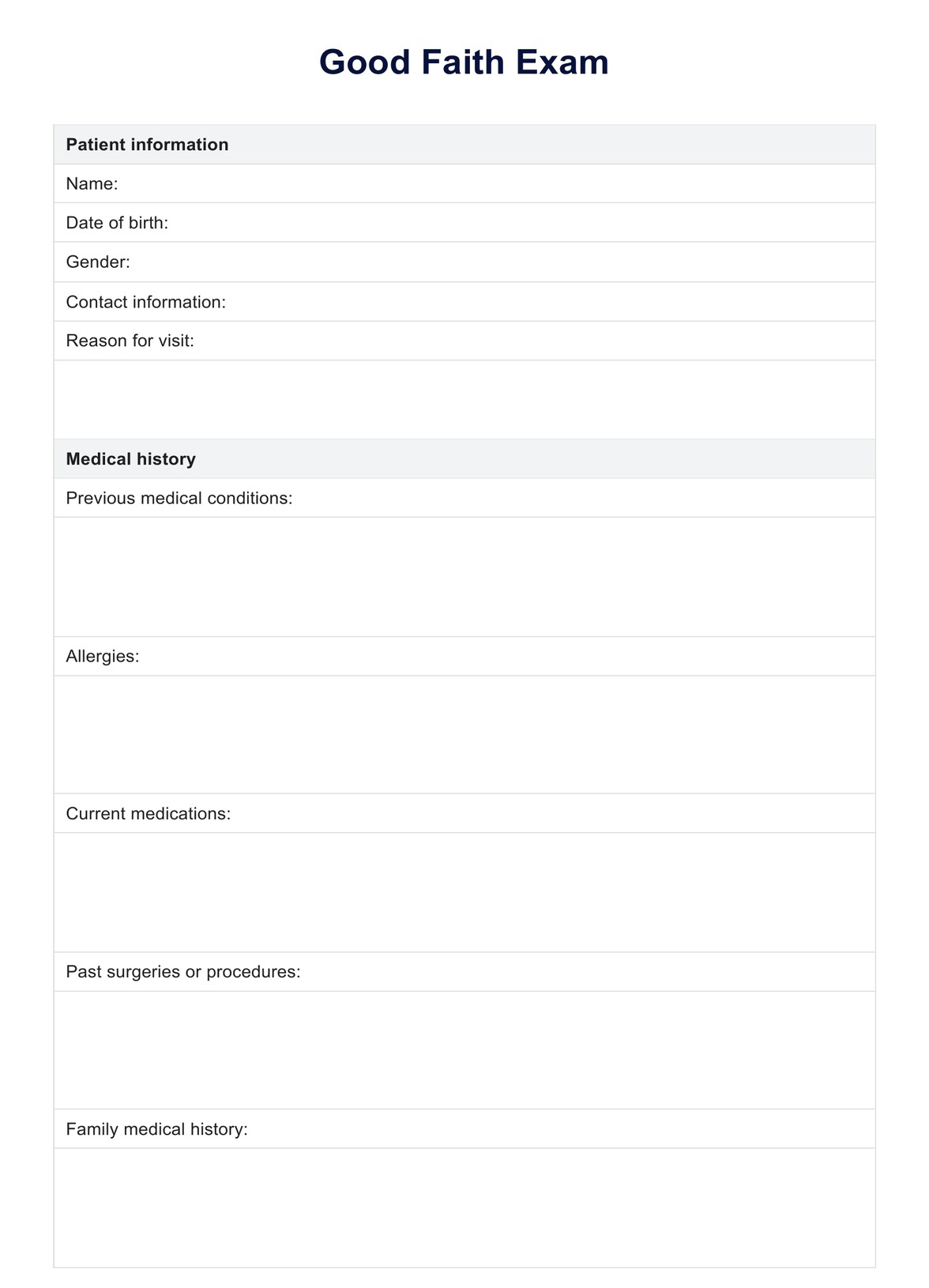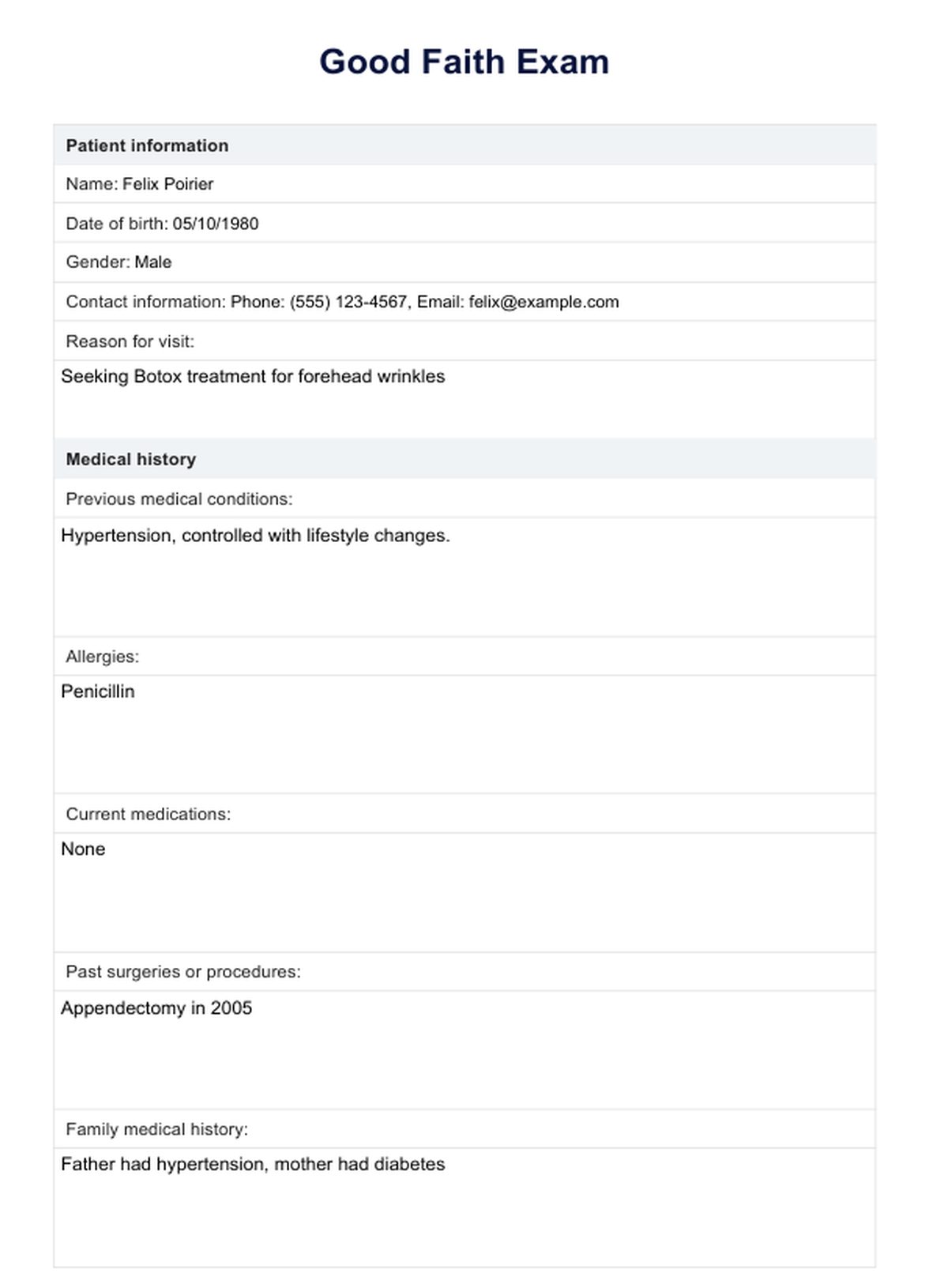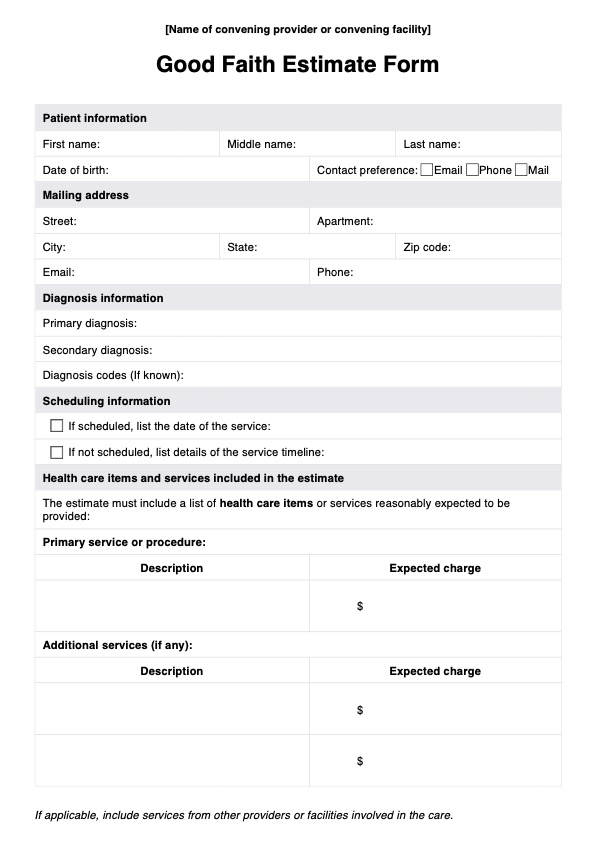Good Faith Exam
Learn about good faith and get examples of good faith exams. Download a free PDF to understand how this principle applies in various situations.


What is a Good Faith Exam?
A Good Faith Exam is a critical assessment conducted by healthcare professionals, such as physicians, nurse practitioners, or physician assistants, to ensure the appropriateness and safety of treatments and procedures. During an initial Good Faith Exam, the practitioner thoroughly reviews the patient's medical record and performs a physical examination to evaluate the patient's physical condition. This process helps identify whether the procedure is medically necessary and if there are any underlying health issues that could affect the outcome of the proposed medical procedure.
The importance of a Good Faith Exam lies in its role in prioritizing patient safety. By thoroughly understanding the patient's medical history and current health status, practitioners can tailor treatments to the patient's individual needs, thus minimizing risks associated with multiple treatments. This is especially relevant in medical spas, where elective procedures are standard. A Good Faith Exam ensures that all treatments are medically justified and that any contraindications are identified beforehand.
A supervising or collaborating physician often oversees the process to maintain high standards of care. In summary, performing a Good Faith Examination is essential for providing safe and effective medical care, as it ensures that all medical procedures are conducted with a comprehensive understanding of the patient's health.
Which healthcare professionals conduct this exam?
Various healthcare professionals can conduct a Good Faith Exam, each playing a vital role in ensuring the safety and appropriateness of medical treatments and procedures. Here is a concise list of the professionals who typically perform these exams:
- Physicians (MDs or DOs)
- Nurse practitioner
- Physician assistant
- Dentists (DDS or DMD)
- Chiropractors
These professionals are trained to conduct thorough evaluations, review medical histories, and ensure that any medical procedure is safe and appropriate for the patient's health.
What does this exam entail?
A Good Faith Exam consists a comprehensive review of the medical records, including past illnesses, surgeries, and current medications. The healthcare professional then conducts a physical examination to assess the patient's overall physical condition. This exam may include checking vital signs, evaluating organ function, and identifying potential health risks.
The goal is to ensure that any planned medical treatments or procedures are safe and appropriate for the patient. This thorough assessment helps prioritize patient safety and tailor medical care to individual needs.
Good Faith Exam Template
Good Faith Exam Example
Benefits of conducting this exam
Here are five key benefits of conducting a Good Faith Exam before performing medical procedures, particularly in settings like medical spas:
Enhanced patient safety
Conducting a thorough Good Faith Examination allows healthcare providers, including registered nurses and physicians, to comprehensively assess the patient's health status. This helps identify any underlying medical conditions or contraindications that could pose risks to the patient receiving medical spa treatments, enhancing overall safety.
Tailored treatment plans
To perform Good Faith Exams, healthcare providers can gather essential information about the patient's medical record and current health status. This enables them to develop personalized treatment plans that address each patient's unique needs and concerns, ensuring optimal outcomes for ongoing treatments in medical spa settings.
Improved patient care
By performing Good Faith Exams, healthcare providers demonstrate a commitment to delivering high-quality patient care. These examinations enable practitioners to prioritize patient well-being and make informed decisions about the suitability of aesthetic medicine procedures, ensuring that treatments align with the patient's health goals and preferences.
Physician oversight
In many jurisdictions, Good Faith Examinations require physician oversight to ensure compliance with medical regulations and standards of practice. This oversight helps maintain accountability and ensures that patients receive care that meets established guidelines, even in telemedicine technology or remote consultations.
Legal and ethical compliance
Conducting Good Faith Exams is a best practice in patient care and a legal and ethical requirement in many healthcare settings. By adhering to the principles of Good Faith Examination, healthcare providers demonstrate their commitment to ethical standards and mitigate the risk of legal challenges related to patient care and treatment outcomes.
What healthcare providers do if patients are not eligible for certain treatments
If a patient is deemed ineligible for certain treatments following a Good Faith Examination, healthcare providers take several steps to ensure the patient's well-being.
First, they communicate openly and transparently with the patient, explaining the reasons for ineligibility and discussing alternative treatment options, if available. Providers may also offer referrals to specialists or other healthcare professionals who can address the patient's specific needs.
Additionally, healthcare providers may provide guidance on lifestyle modifications or preventive measures that can support the patient's health goals.
Are Good Faith Exams standardized for all healthcare providers?
No, Good Faith Exams are not standardized across all healthcare providers. While there are general guidelines and best practices for conducting Good Faith Examinations, the specific protocols may vary based on factors such as the type of healthcare setting, specialty, and jurisdictional regulations.
Healthcare providers are responsible for ensuring that their Good Faith Examination practices align with relevant professional standards and legal requirements to uphold patient safety and quality of care.
Commonly asked questions
A Good Faith Exam typically includes a review of the patient's medical history, a comprehensive physical examination, an assessment of the patient's suitability for a specific medical procedure, a discussion of risks and benefits with the patient, and documentation of findings and recommendations.
Good Faith Exams can be used in various healthcare settings, including medical spas, primary care clinics, specialty practices, surgical centers, and telemedicine platforms, to ensure the safety and appropriateness of medical treatments and procedures.
Licensed healthcare professionals such as physicians (MDs or DOs), nurse practitioners (NPs), physician assistants (PAs), registered nurses (RNs), and other qualified healthcare providers can perform Good Faith Exams within their scope of practice and under appropriate supervision or collaboration.








































































































